 W
WRoman currency for most of Roman history consisted of gold, silver, bronze, orichalcum and copper coinage. From its introduction to the Republic, during the third century BC, well into Imperial times, Roman currency saw many changes in form, denomination, and composition. A persistent feature was the inflationary debasement and replacement of coins over the centuries. Notable examples of this followed the reforms of Diocletian. This trend continued into Byzantine times.
 W
WAes rude was a nugget of bronze used as a sort of proto-currency in ancient Italy prior to the use of minted coins made from precious metals.
 W
WAes signatum consisted of cast ingots of bronze of measured quality and weight, embossed with a government stamp, used as currency in Rome and central Italy before the introduction of aes grave in the mid 4th century BC. When exactly they were first made is uncertain. Popular tradition ascribes them to Servius Tullius, but due to the high quality of art found on even the earliest specimens, this seems very unlikely. A date in the midst of the 5th century BC is generally agreed on. Designs featured are that of a bull, an eagle, and other religious symbols.
 W
WThe antoninianus, or pre-reform radiate, was a coin used during the Roman Empire thought to have been valued at 2 denarii. It was initially silver, but was slowly debased to bronze with a minimal silver content. The coin was introduced by Caracalla in early 215 AD. It was silver, similar to the denarius except that it was slightly larger and featured the emperor wearing a radiate crown, indicating it was a double denomination. Antoniniani depicting women featured the bust resting upon a crescent moon.
 W
WThe argenteus was a silver coin produced by the Roman Empire from the time of Diocletian's coinage reform in AD 294 to ca. AD 310. It was of similar weight and fineness to the denarius of the time of Nero. The coin was produced at a theoretical weight of 1/96th of a Roman pound, as indicated by the Roman numeral XCVI on the coin's reverse.
 W
WThe as, occasionally assarius was a bronze, and later copper, coin used during the Roman Republic and Roman Empire.
 W
WThe aureus was a gold coin of ancient Rome originally valued at 25 pure silver denarii. The aureus was regularly issued from the 1st century BC to the beginning of the 4th century AD, when it was replaced by the solidus. The aureus was about the same size as the denarius, but heavier due to the higher density of gold.
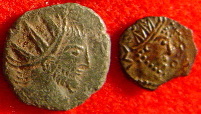 W
WBarbarous radiates are imitations of the antoninianus, a type of coin issued during the Roman Empire, which are so named due to their crude style and prominent radiant crown worn by the emperor.
 W
WIn the currency of ancient Rome, the bigatus is a type of denarius stamped on the reverse with a biga, a two-horse chariot. It began to appear in the first decade of the 2nd century BC as an alternative to the victoriatus, and most numismatists believe that it was not used before 190 BC. A denarius with a four-horse chariot (quadriga) had already been in use for some time; see quadrigatus, likewise named for its chariot icon and depicting in addition the Dioscuri.
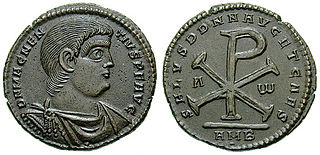 W
WThe bronze centenionalis coins were the attempts of Constans and Constantius II to reintroduce a large bronze coin between 320 and 340 AD, as the follis had by then shrunk dramatically. The type of coin it was is uncertain, but numismatists have categorized large bronze coins of the above date under this denomination. The centenionalis, however, did not last long. By the end of Theodosius the Great's rule, only smaller varieties of bronze coins were minted.
 W
WThe cistophorus was a coin of ancient Pergamum. It was introduced shortly before 190 B.C. at that city to provide the Attalid kingdom with a substitute for Seleucid coins and the tetradrachms of Philetairos. It also came to be used by a number of other cities that were under Attalid control. These cities included Alabanda and Kibyra. It continued to be minted and circulated by the Romans with different coin types and legends, but the same weight down to the time of Hadrian, long after the kingdom was bequeathed to Rome. It owes its name to a figure, on the obverse, of the sacred chest of Dionysus.
 W
WThe coinage reform of Augustus refers to the reform of Roman currency undertaken by Augustus in 23 BC.
 W
WIn numismatics, the term Constantinian bronzes denotes the series of bronze coins issued in the Roman Empire in the middle of the 4th century. The specific denominations are unclear and debated by historians and numismatists. They are referred to as AE1, AE2, AE3, and AE4, with the former being the largest and the latter the smallest in diameter:
 W
WThe denarius was the standard Roman silver coin from its introduction in the Second Punic War c. 211 BC to the reign of Gordian III, when it was gradually replaced by the Antoninianus. It continued to be minted in very small quantities, likely for ceremonial purposes, until and through the tetrarchy (293–313).
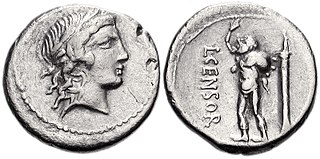 W
WIn 82 BC, a denarius was minted by Lucius Marcius Censorinus picturing Apollo and Marsyas the satyr. The coin has attracted several interpretations because of the ambiguity of its symbolism.
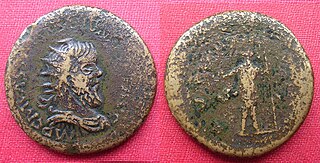 W
WThe double sestertius was a large Roman coin made of orichalcum (brass) first issued by Trajan Decius in AD 249-251, as a response to the inflationary pressures of the time which had devalued the buying power of the conventional sestertius. In reality the new coin was little bigger than the traditional sestertius, which by then was being manufactured at a lower weight and smaller size than it had originally been, and was not a success.
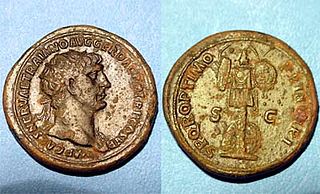 W
WThe dupondius was a brass coin used during the Roman Republic and Roman Empire valued at 2 asses.
 W
WThe follis was a type of coin in the Roman and Byzantine traditions.
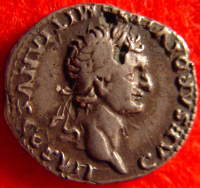 W
WA fourrée is a coin, most often a counterfeit, that is made from a base metal core that has been plated with a precious metal to look like its solid metal counterpart. The term is normally applied to ancient silver-plated coins such as the Roman denarius and Greek drachma, but the term is also applied to other plated coins.
 W
WGreek coinage of Italy and Sicily originated from local Italiotes and Siceliotes who formed numerous city states. These Hellenistic communities descended from Greek migrants. Southern Italy was so thoroughly hellenized that it was known as the Magna Graecia. Each of the polities struck their own coinage.
 W
WJudaea Capta coins were a series of commemorative coins originally issued by the Roman Emperor Vespasian to celebrate the capture of Judaea and the destruction of the Jewish Second Temple by his son Titus in 70 AD during the First Jewish Revolt. There are several variants of the coinage. The reverse of the coins may show a female seated right in an attitude of mourning at the base of a palm tree, with either a captive bearded male standing left, with his hands bound behind his back, or the standing figure of the victorious emperor, or the goddess Victoria, with a trophy of weapons, shields, and helmets to the left.
 W
WThe Lava Treasure is the Roman treasure of coins and the gold plate that was discovered underwater in the small Gulf of Lava, southern Corsica, France, probably in 1958. Also known as the “Corsica hoard”, or “Mediterranean Sea hoard”. It is considered one of world’s most important archaeological finds, and presents a unique testimony for our knowledge of Roman imperial coinage.
 W
WLegionary denarii is the modern name for a series of Roman silver denarius coins issued by Mark Antony in the eastern Mediterranean during the last war of the Roman Republic from 32 to 31 BC, in the lead up to the Battle of Actium. The coinage is also referred to by numismatists as RRC 544/1-39, after its designation in M. H. Crawford, Roman Republican Coinage (1975).
 W
WA litra is a small silver coin used in the colonies of Ancient Greece in general and in ancient Sicily in particular. As a coin, the litra was similar in value to the obol and weighed one-third of a Roman libra, i.e. 109.15 g (3.850 oz). In silver content alone, the coin weighed 0.87 g (0.031 oz) and was equal to one-fifth of a drachma.
 W
WThe miliarense was a large silver coin, introduced to the late Roman monetary system in the early 4th century. It was struck with variable fineness, generally with a weight between 3.8 and 6.0 grams, and a diameter of c. 23–24 mm. The miliarense was struck first under Constantine the Great.
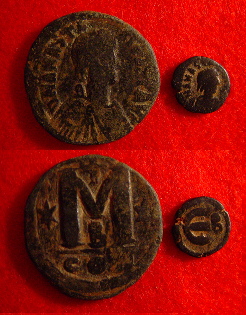 W
WNummus, plural nummi (νοῦμμοι) is a Latin term meaning "coin", but used technically by modern writers for a range of low-value copper coins issued by the Roman and Byzantine empires during Late Antiquity. It comes from the Greek nomos via its Western Doric form noummos, which was used to describe a coin in some parts of southern Italy. The word was also used during the later years of the Roman Republic and the early Empire, either as a general word for a coin, or to describe the sestertius, which was the standard unit for keeping accounts.
 W
WOrichalcum or aurichalcum is a metal mentioned in several ancient writings, including the story of Atlantis in the Critias of Plato. Within the dialogue, Critias claims that orichalcum had been considered second only to gold in value and had been found and mined in many parts of Atlantis in ancient times, but that by Critias's own time orichalcum was known only by name.
 W
WPrutah is a Hebrew term, possibly derived from Aramaic. It refers to a small denomination coin.
 W
WThe quadrans or teruncius was a low-value Roman bronze coin worth one quarter of an as. The quadrans was issued from the beginning of cast bronze coins during the Roman Republic with three pellets representing three unciae as a mark of value. The obverse type, after some early variations, featured the bust of Hercules, while the reverse featured the prow of a galley. Coins with the same value were issued from other cities in Central Italy, using a cast process.
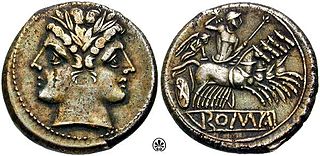 W
WThe quadrigatus was a medium-sized silver coin produced by the Roman Republic during the 3rd century BC. The obverse featured a young janiform bust and the reverse featured Victory driving a quadriga, giving the coin its Roman name, with the inscription "ROMA" below.
 W
WThe quinarius was a small silver Roman coin valued at half a denarius.
 W
WThe quincunx was a bronze coin minted during the Roman Republic. It was not part of the standard coinage of the Roman monetary system. The quincunx was produced only during the Second Punic War, by mints at Luceria, Teate, Larinum, and northern Apulia. After the defeat of Cannae during the Second Punic War, a coin with the same value was minted in Capua.
 W
WThe post-reform radiate, was a Roman coin first issued by Diocletian during his currency reforms of AD 293–310. The radiate looked very similar to the Antoninianus, with a radiate crown, similar to the one worn by the Roman deity, Sol Invictus. It is different from the Antoninianus because of the absence of the "XXI" that existed on pre-reform radiates, a symbol believed to have indicated a consistence of 20 parts bronze to 1 part silver. The post-reform radiate had little or no silver content. The weight can vary between 2.23 and 3.44 grams.
 W
WThe Reka Devnia Hoard was the most prolific find of Roman silver coins of the period from 64 to 251 AD to have ever been published. It was found near the town of Devnya, north-eastern Bulgaria. The hoard consisted of 81,044 denarii found in 1929. The earliest coins were those of Marc Antony of which twenty-nine were found, and the latest being one example of Herennius Etruscus. The hoard was broken into two, with 68,783 coins sent to the museum of Sofia, and 12,261 to Varna.
 W
WThe semis, literally meaning half, was a small Roman bronze coin that was valued at half an as. During the Roman Republic, the semis was distinguished by an 'S' or 6 dots. Some of the coins featured a bust of Saturn on the obverse, and the prow of a ship on the reverse.
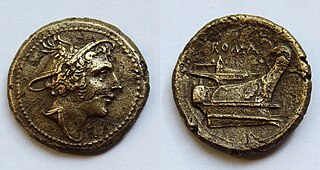 W
WThe semuncia was an ancient Roman bronze coin valued at one twenty-fourth of an as, or half an uncia, produced during the Roman Republican era. It was made during the beginning of Roman cast bronze coinage as the lowest valued denomination.
 W
WThe sestertius, or sesterce, was an ancient Roman coin. During the Roman Republic it was a small, silver coin issued only on rare occasions. During the Roman Empire it was a large brass coin.
 W
WThe sextans was an Ancient Roman bronze coin produced during the Roman Republic valued at one-sixth of an as. The most common design for the sextans was the bust of Mercury and two pellets on the obverse and the prow of a galley on the reverse. Earlier types depicted a scallop shell, a caduceus, or other symbols on the obverse.
 W
WThe siliqua is the modern name given to small, thin, Roman silver coins produced in the 4th century A.D. and later. When the coins were in circulation, the Latin word siliqua was a unit, perhaps of weight defined by one late Roman writer as one twenty-fourth of a Roman solidus."Siliqua vicesima quarta pars solidi est, ab arbore, cuius semen est, vocabulum tenens."A siliqua is one-twentyfourth of a solidus [coin] and the name is taken from the seed of a tree.
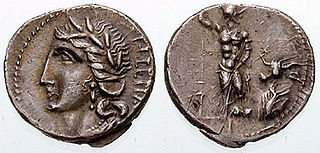 W
WThe family of Social War coinage include all the coins issued by the Italic allies of the Marsic confederation, Marsi, Peligni, Piceni, Vestini, Samnites, Frentani, Marrucini, and Lucani, during the Social War against Rome.
 W
WThe solidus, nomisma, or bezant was a highly pure gold coin issued in the Late Roman Empire and Byzantine Empire. Constantine introduced the coin, and its weight of about 4.5 grams remained relatively constant for seven centuries. In the Byzantine Empire, the solidus or nomisma remained a highly pure gold coin until the 11th century, when several Byzantine emperors began to strike the coin with less and less gold. The nomisma was finally abolished by Alexius I in 1092, who replaced it with the hyperpyron, which also came to be known as a "bezant". The Byzantine solidus also inspired the originally slightly less pure dinar issued by the Muslim Caliphate. In Western Europe, the solidus was the main gold coin of commerce from late Roman times to Pepin the Short's currency reform, which introduced the silver-based pound/shilling/penny system.
 W
WA spintria is a small bronze or brass Roman token, possibly for use in brothels, although none of the literature on the spintriae contains any evidence to support this assertion. The tokens usually depict on the obverse a motif of sexual acts or symbols and a numeral in the range I - XVI on the reverse.
 W
WThe tremissis or tremis was a small solid gold coin of Late Antiquity. Its name, meaning "a third of a unit", formed by analogy with semissis, indicated its value relative to the solidus. It was introduced into Roman currency in the 380s by the Emperor Theodosius I and initially weighed 8 siliquae.
 W
WThe triens was an Ancient Roman bronze coin produced during the Roman Republic valued at one-third of an as. The most common design for the triens featured the bust of Minerva and four pellets on the obverse and the prow of a galley on the reverse. It was not a common denomination and was last struck c. 89 BC.
 W
WThe uncia was a Roman currency worth one twelfth of an as.
 W
WThe victoriatus was a silver coin issued during the Roman Republic from about 221 BC to 170 BC. The obverse of the coin featured the bust of Jupiter and the reverse featured Victory placing a wreath upon a trophy with the inscription "ROMA" in exergue.The name victoriatus is an ancient term, attested by several contemporary texts and inscriptions. The coin was known as a tropaikon among Greek speakers.